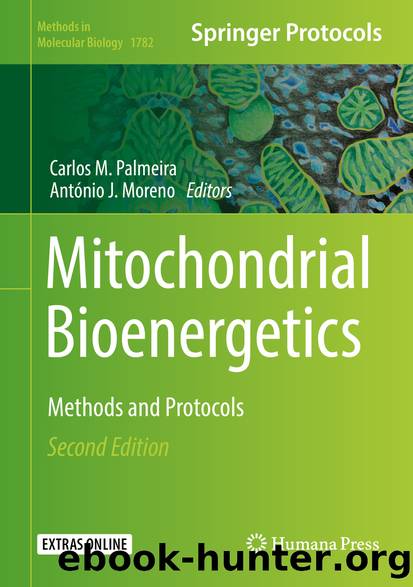Mitochondrial Bioenergetics by Carlos M. Palmeira & António J. Moreno

Author:Carlos M. Palmeira & António J. Moreno
Language: eng
Format: epub
Publisher: Springer New York, New York, NY
1.6 Cytochromes
Complex III and Complex IV contain hemoproteins termed âcytochromesâ which are readily detected by spectrophotometry. These were used as early as 1952 to measure mitochondrial redox changes in cells [15]. The measurements of the redox states of cytochromes depend upon the absorbance characteristics of the hemes in the cytochromes, which have more intense absorbance in the reduced forms (Fig. 1) [13]. In the visible range, the absorbance bands are termed α, β, and γ (Soret) absorbance bands. While the Soret band has the greatest extinction coefficients, it occurs at the shortest wavelength where there is the greatest light scatter in preparations containing mitochondria; consequently, measurements in this region can be more prone to error due to this light scatter. In addition, there is considerable overlap of signals from hemes b and c, and these can be further obscured by signals from myoglobin or hemoglobin [30]. Consequently, measurements in the Soret region are usually limited to cytochromes a 3. Cytochromes a and a 3 contain heme a, which is structurally distinct from heme b, present in hemoglobin, myoglobin, catalase, and b- and c-type cytochromes. Cytochromes a and a 3 also absorb light in the near-infrared region, and this has provided a means to measure oxidation in vivo [17]. Considerable spectral overlap occurs with the β bands, so most measurements are obtained with the α bands. Cytochromes b and c contain heme b (Fe-complexed protoporphyrin IX) but differ in absorbance because the heme is covalently bound in cytochromes c and c1 but not in b H or b L. Other minor differences in absorbance maxima occur due to the interactions with amino acids in the vicinity of the heme. Addition of ligands like KCN , which bind to the O2 site, can be used to discriminate cytochromes a and a 3. However, this is not useful for steady-state redox measurement because it blocks electron flow .
Complex III accepts two electrons from CoQ and transfers one to cytochrome c 1 and the other to the cytochrome b H and b L pair. The electron from cytochrome c 1 is then transferred to cytochrome c, while the electron from cytochrome b is transferred back to CoQ. The system is a proton pump, with energetics of proton pumping probably defined by steady-state potential of the donor ubiquinol/ubisemiquinone couple and cytochrome c 1. As above, changes in the steady-state E h values determine the energetics available for proton pumping. Consequently, interpretations of Complex III function in generation of ÎμH+, ROS generation or support of ATP production, are limited by changes in steady-state E h values which determine the available ÎE h.
Steady-state reduction of cytochromes b is measured by dual-wavelength measurement with 575 as an isosbestic point. Absorbance maxima for the two forms are at 561 and 566 nm, but the signals overlap considerably so that redox changes of the mixture are most readily obtained by measuring absorbance at 562 nm relative to 575 nm. The extinction coefficient value for 562 nm minus 575 nm is 23/mM/cm.
Download
This site does not store any files on its server. We only index and link to content provided by other sites. Please contact the content providers to delete copyright contents if any and email us, we'll remove relevant links or contents immediately.
| Administration & Medicine Economics | Allied Health Professions |
| Basic Sciences | Dentistry |
| History | Medical Informatics |
| Medicine | Nursing |
| Pharmacology | Psychology |
| Research | Veterinary Medicine |
Periodization Training for Sports by Tudor Bompa(8097)
Why We Sleep: Unlocking the Power of Sleep and Dreams by Matthew Walker(6557)
Paper Towns by Green John(5023)
The Immortal Life of Henrietta Lacks by Rebecca Skloot(4447)
The Sports Rules Book by Human Kinetics(4213)
Dynamic Alignment Through Imagery by Eric Franklin(4050)
ACSM's Complete Guide to Fitness & Health by ACSM(3938)
Kaplan MCAT Organic Chemistry Review: Created for MCAT 2015 (Kaplan Test Prep) by Kaplan(3906)
Introduction to Kinesiology by Shirl J. Hoffman(3699)
Livewired by David Eagleman(3623)
The River of Consciousness by Oliver Sacks(3498)
The Death of the Heart by Elizabeth Bowen(3483)
Alchemy and Alchemists by C. J. S. Thompson(3422)
Bad Pharma by Ben Goldacre(3208)
Descartes' Error by Antonio Damasio(3188)
The Emperor of All Maladies: A Biography of Cancer by Siddhartha Mukherjee(3025)
The Gene: An Intimate History by Siddhartha Mukherjee(3014)
The Fate of Rome: Climate, Disease, and the End of an Empire (The Princeton History of the Ancient World) by Kyle Harper(2975)
Kaplan MCAT Behavioral Sciences Review: Created for MCAT 2015 (Kaplan Test Prep) by Kaplan(2903)
